Whichever way we identify the position of the pedal bone we then have to decide on how we should trim the foot.
Should there be a difference when dealing with Robert Eustace's chronic founder Type 1 (There are sufficient laminae to maintain support of the pedal bone) and chronic founder Type 2, (insufficient healthy laminae to support the bone satisfactorily) [Explaining Laminitis and its Prevention - Robert Eustace], or Steve O'Grady's capsular rotation (the hoof capsule diverges from the dorsal surface of P3) and phalangeal rotation (P3 is displaced in relation to the long axis of P1 and P2) [Managing Chronic Laminitis - Equine Veterinary Education S.E.O'Grady Vol14 No 3 June 2002]?
"Lower the heel and shorten the toe"
| John Nicol - BVA Congress in 1972 "Where pedal rotation has occurred, corrective trimming must be used to lower the heels and bring the pedal bone horizontal to the ground thus providing frog pressure, the toe should be trimmed correspondingly." |
| C.R.Adams - Lameness in Horses "The fundamental principal of this treatment is to lower the heel so that the distal border of the third phalanx will parallel the surface of the ground when the foot is bearing weight." |
| R.F.Redden of the International Equine Podiatry Centre "Those with rotation were de-rotated by rasping the heels in a manner that established a parallel line between the ground surface and the solar surface of the coffin bone" |
| Robert Eustace - Explaining Laminitis and its Prevention "The aim of foot treatment in the chronic founder case is to restore the relationship between the phalangeal bones, the hoof and the ground to as near normality as possible". |
| Dr Hiltrud Strasser - A Lifetime of Soundness "The normal position of the coffin bone is parallel to the ground, with the joint surface in the top centre of the bone. The horse's weight coming down on this bone is distributed relatively equally to all parts of the hoof capsule and, as such, to all parts of the laminae.". |
| Steve O'Grady - Lecture to the BEVA laminitis meeting in December 2002, "When
managing chronic laminitis, it seems to make little difference which shoeing
system is used, as long as the method achieves the following goals:
|
So are all these the same?
Certainly five of them suggest that the feet should be trimmed so that the solar surface of P3 is parallel to the ground. Robert Eustace, however, suggests that the heel should be trimmed so that the position of P3 is returned to its "normal" position, but what is a "normal position?" Robert Eustace has come to his decision by returning the pedal bone so that it is lined up with P1 and P2, and he believes the normal position to be 8°-10° , but Dr Strasser believes the normal position to be with a ground-parallel pedal bone.
Rick Redden, Steve O'Grady and those that use the Equine Digital Support System (EDSS) advocate the trimming of the hoof to give a horizontal P3 solar surface, but then they apply wedges or rails, the greatest being Dr Redden who will sometimes apply three 6 wedges (18 ) to his trimmed feet.
These are all opinions of veterinary surgeons over the past 30 years, but have farriers been of the same opinion?
So who is correct?
When deciding on what angle the feet are trimmed, the question that we have to consider is whether the pull of the deep flexor tendon is of more significance than the effect of the weight of the horse on a tilted pedal bone.
It would appear that most are agreed that the aim is to establish weight bearing "along the entire solar surface" (O'Grady), or to "all parts of the hoof capsule" (Strasser) and that this is brought about by trimming the foot with a P3 solar surface that is parallel to the ground.
The pedal bone (below) is shown flat and then tilted 5°, 10° , 15° and 20°.
The weight of the horse is depicted as a black arrow near the centre of mass of the pedal bone.
This vertical force is depicted in two dimensions and is split with the red arrow showing the force going down the dorsal surface of the bone towards the toe and at right-angles to this, the green arrow, the force to the heel.
It shows how the force along the dorsal surface increases significantly as the bone is tilted, so that if the foot is trimmed with a 20° solar angle then there will be almost twice as much force going down the dorsal surface to the toe than is being applied to the lateral processes at the heel.
If this is the case then, trimming the feet with the solar surface parallel to the ground, the weight of the horse will be distributed evenly around the whole of P3.
The pull of the deep flexor tendon.
| " In some cases In some cases of founder another complicating factor may start to operate. The muscle which works the deep digital flexor tendon starts to work overtime and contract. The reasons for this are unknown but may be related to the animals individual pain threshold and the founder distance. As the muscle contracts the pedal bone is pulled more and more away from the inside of the hoof wall" Robert Eustace |
| " If the hoof angle is lowered by trimming the heel it increases maximal tension in the deep digital flexor tendon in walking horses, and raising the hoof angle decreased maximal tension." (Lockner et al. 1980, Riemersma et al. 1996) |
Is this of greater significance in rotation of the pedal bone in laminitis than the weight of the horse on a tilted bone.
In deciding the significance of the pull of the deep flexor tendon, there are a number of points we have to consider.
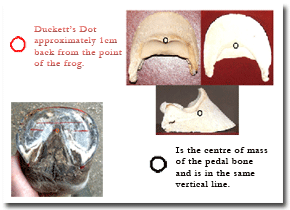
If the pedal bone has a flat solar surface then the insertion of the deep flexor tendon will be in a direct vertical line below the insertion of the extensor tendon and the vertical part of the articular surface of P3 and above Duckett's Dot approximately 1cm back from the point of the frog. Figure 3 Is the centre of mass of the pedal bone and is in the same vertical line. (see right)
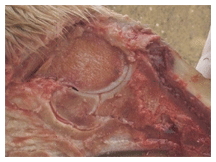
The insertion of the deep flexor tendon inserts on the semi-lunar crest and
the flexor surface of the pedal bone behind it, so some of it inserts just below
and some just behind the centre of mass of the bone. (see left)

In a normal standing horse there will be tone in the deep flexor muscle applying
tension to the deep flexor tendon, and these are part of the "stay apparatus"of
the foreleg. (Horse Anatomy - P Goody)
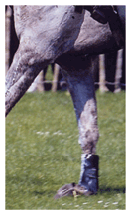
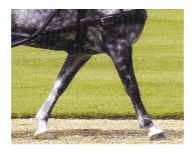
This tension will be increased significantly, when the horse is moving, and will be at a maximum;
....at mid stance when the full weight of the horse is on the leg (left image)
....but also when the deep flexor muscle contracts in order to flex the pastern and coffin joint at breakover.(right image)
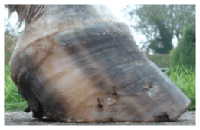 This second part is particularly of significance in the laminitic horse or
pony because if the laminae are week and separated and the toe is too long,
the delayed breakover will pull the wall
This second part is particularly of significance in the laminitic horse or
pony because if the laminae are week and separated and the toe is too long,
the delayed breakover will pull the wall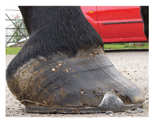 away from the bone. It is for this reason that it is vitally important to make
sure the toe is cut back sufficiently to allow easy breakover. Steve O'Grady's
second instruction (see above).
away from the bone. It is for this reason that it is vitally important to make
sure the toe is cut back sufficiently to allow easy breakover. Steve O'Grady's
second instruction (see above).
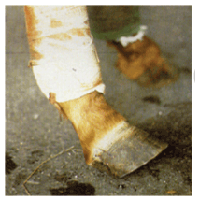 If the DFT ruptures or is cut below the fetlock then the foot will tilt up
at the toe. (Photo from Colour Atlas of the Horse's Foot - Chris Pollitt). This
is not surprising since a greater part of the weight of the horse passing down
the bone column through P2 will be behind the centre of mass of P3.
If the DFT ruptures or is cut below the fetlock then the foot will tilt up
at the toe. (Photo from Colour Atlas of the Horse's Foot - Chris Pollitt). This
is not surprising since a greater part of the weight of the horse passing down
the bone column through P2 will be behind the centre of mass of P3.
So as weight is taken on the foot, P2 will also apply pressure to the navicular bone, and this will increase the tension in the DFT which will stabilise P3 and stop it tilting. The greater the force passing down the leg, the greater the tendency for P3 to tilt backwards but also the greater the tension in the DFT and its pull becomes more horizontal maintaining the foot level.
So should we be trimming the foot so that P3 has a flat solar surface or at, according to Robert Eustace, a more normal angle of 8-10 in order to reduce the tension in the DFT? Or for that matter should we be trimming the foot with a flat solar surface to P3 and then raise the heel with wedges? Both of these will move the centre of mass of P3 posteriorly so that greater force will pass to the toe (see Figure 9)
| "Quoting Robert Eustace again "The muscle which works the deep digital flexor tendon starts to work overtime and contract."" Robert Eustace |
So why should this be? There is no evidence to show that the Deep Flexor Muscle is affected directly in laminitis, so it presumably contracts due to the changes and pain occurring in the foot.
The cause of the pain in the foot is a matter that is still under debate but I believe that it occurs when the laminae are stretched and from the pressure of the pedal bone on the solar corium and not due to pressure from oedema or from an ischaemic response due to constriction of the blood vessels.
Whatever the cause of pain in the feet, it seems that there is reflex contraction of the Deep Flexor muscle which goes into spasm. Continuous spasm causes hypoxia and ischaemia in the muscle that stimulates pain receptors in it and this pain initiates more muscle spasm.
Now our problem is to decide whether we should trim the foot with a lower heel to spread the load around the whole of P3 to reduce the pain in the foot or whether we should raise the heel in order to relieve the pain and extra pull from the deep flexor muscle and tendon.
I believe we should be trimming the feet of chronic founder animals so that the solar surface is parallel to the ground and we should not then be tilting them up with wedges.
If we trim the feet with a ground-parallel pedal bone:
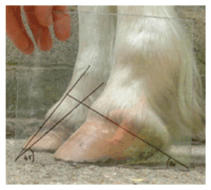
- As weight is applied down the leg, the load is spread more evenly around all the laminae rather than particularly down the dorsal wall.
- It will also reduce the pressure applied by P3 on the solar corium at the toe.
- This will hopefully reduce the pain in the feet and with it the reflex contracture of the deep flexor muscle and thus reducing the tension in the deep flexor tendon. (I now advise massage of the deep flexor muscle following trimming of the heels).
- There should be less pressure applied by the extensor process of a rotated P3 on the coronary papillae of the dorsal hoof wall and this should allow more even growth of the hoof.
- There will be a more even pressure around the whole of the coronet and this will mean that new horn growth is more likely to grow down parallel to the dorsal surface of P3 allowing the basement membrane that has not been irrevocably damaged to bind, as best it can, the epidermal and dermal laminae together providing a stronger and more stable foot.
- Chronic founder cases are unlikely, certainly initially, to be involved in great athletic activity, but when there is sufficient new hoof growth and stability is achieved we can then trim the foot to a more "normal" angle.
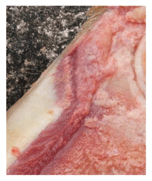
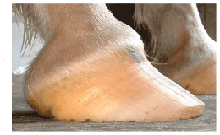
However, if we lower the heel we will have a toe that is "long", particularly if there is already distortion of the dorsal hoof wall. It is imperative that the toe is taken back sufficiently to allow easy break-over and thus avoid any pulling on the weakened laminae by the dorsal wall otherwise it will be pulled away from the bone
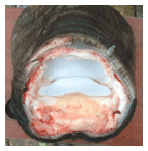
If we leave P3 rotated
- The centre of mass is moved posteriorly, thus putting more weight down the dorsal wall and pressure on the solar corium.
- There is likely to be more distortion of the coronary papillae of the dorsal hoof wall.
- This will, in turn, result in slower growth of horn at the toe compared to the heel.
The images seen below are just a few examples of chronic founder feet (of which I have over 100), some with deviation of the dorsal wall and some without.
Although most farriers seem to agree with the basic principle of "lowering the heel and shortening the toe", so many chronic founder cases are still left with excessively rotated pedal bones and recurrent episodes of lameness.
 |
The Equine Digital Support System (EDSS) has benefited many chronic founder cases by the lowering of the heel, the shortening of the toe and by giving frog support. I feel that this system then reduces its benefit when wedges or rails are applied and I am finding that quite a number of farriers who use this system are no longer fitting the rails having been disappointed by the results. If there is a benefit then I suggest it would be for their application for days rather than weeks.
I believe that the weight of the horse on the pedal bone is more important than the pull of the deep flexor tendon so that it is more important to trim the feet of chronic founder cases with a ground-parallel pedal bone and that raising the heel to decrease the tension in the DFT is more likely to lead to continuation of the distortion and instability in the feet. The toe must always be taken back to allow breakover without pulling the dorsal wall away from the pedal bone.
Further Thoughts and comments.
WHY DO WE FAIL
If there was a treatment or management regime that worked every time then we would all be doing it. Some cases seem to respond to our chosen line of treatment but then we find that others just continue or sink or rotate regardless.
Over the past thirty years there have been significant advances in our knowledge about laminitis, and some treatments have been discarded, some have been rejected and have been accepted again, but the only piece of advice that has persisted is to "lower the heel and trim the toe".
The following are some thoughts on why we might fail and why we might succeed.
1. Why is it the front feet that are affected most frequently?
The front feet take 50% more weight than the hind feet. 60% front 40% hinds so each front 30% and each hind 20%. Is it possible that another factor is that farriers trim hind feet most of the time with ground-parallel pedal bones! (Most farriers will be unaware of the angle they trim the hind feet but they seem to trim them pretty consistently to 55° ).
2. Benefits from dorsal wall resection.
The benefits are reported to be due to the release of fluid pressure. Could the benefits seen be just due to improved trimming of the feet and the fact that it prevents leverage of the dorsal wall away from P3? This can be done just as well by taking back the breakover point but leaving the stability of a continuous hoof wall. If a resection is done then the side walls may have increased pressures on them that may cause separation unless the hoof is stabilised. If it was that effective why has it "gone out of fashion"? Why not do it the easy way?
3. Benefits of deep flexor tenotomy.
How can we justify cutting a major and important "organ" in an already crippled animal?
Reported to reduce the pull of the deep flexor tendon and its rotational effect. If it was effective every time then there might be some justification, but some "have to" be repeated? It surprised me to know that cutting the tendon mid cannon resulted in separation of the two ends by only an inch but if below the fetlock then the fetlock will drop and the pedal bone will tilt. Could the reason it works be because by cutting the tendon then the navicular bone loses the support of the sling - the tendon? There is apparently sufficient support from the cut tendon to maintain the limb in a fairly normal position, so there is still support to the navicular bone from the DFT. If this support is reduced then as weight is applied to the leg then the tendency will be for the navicular bone to tend to drop more with the articulation of P2 in relation to P3 and weight will be applied further behind the centre of mass of P3 and thus put more pressure toward the heel, taking the pressure off the toe. Those who carry out this procedure all seem to be convinced that the pull of the DFT is the major factor causing rotation and will be the ones who are applying the wedges to the heels thus tilting the foot to put more pressure down the dorsal surface - thus causing more pain.
4. When I was studying at university, the advice was to trim the feet down and walk the horse. Presumably some horses got better but then again no doubt many others got worse.
Walking a laminitic depends on one factor: Stability.
There are a number of factors that determine whether the condition is going to get worse with walking.
- The intensity of the cause - likely to be dose related for the trigger factor.
- How evenly the load is spread - flat pedal bone or not
- How much walking
- The length of the toe
I am convinced that walking is of benefit if there is stability. It has been shown that glucose is vitally important in maintaining the integrity of, if not the basement membrane itself then the bonds between the basement membrane and the layer of epidermal cells attaching to the basement membrane.
It seems that the insulin resistance that occurs in the Cushings horse or one with "metabolic syndrome" affects this layer and weakens it so that when a laminitic episode occurs then the changes will be that much greater.
In Type 1.Diabetes in humans it has been known for a long time that if exercise is taken then the dose of insulin has to be decreased (or food increased). Type 2. Diabetes in humans (with insulin resistance) is managed by changes in diet and by taking exercise. In horses and ponies that are overweight and/ or prone to laminitis, what do we do? We change their diet but then confine them to small areas so that they are unable to exercise and get the circulation going in the feet.
I think that exercise is important in the healing process and there is probably no better way to improve circulation and get rid of waste products following laminitis than exercise, rather than trying to medicate the horse with drugs that supposedly do the same job. It does rely on stability of the pedal bone in the foot. If P3 is tilted or rotated then it is very likely walking will make the problem worse.
Alternatively download the original document from my downloads page